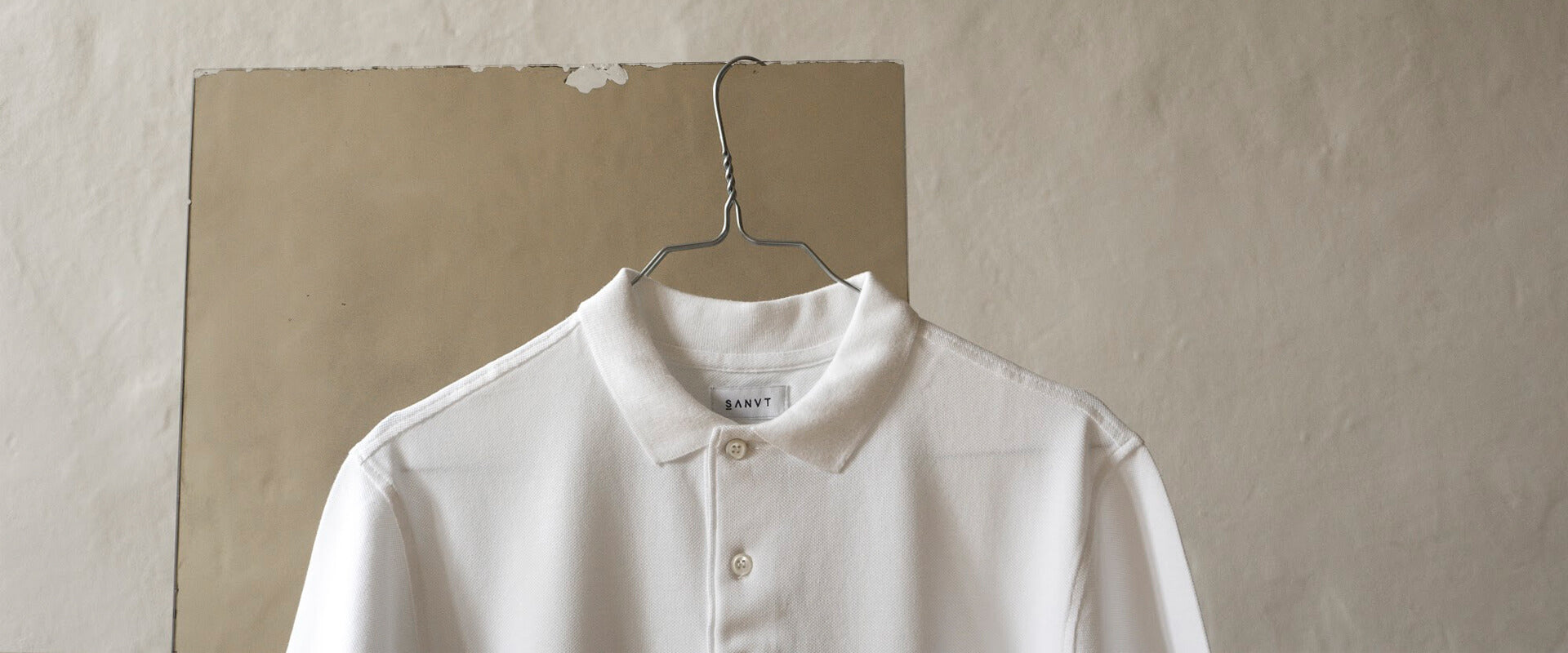Most men (or at least soccer fans) associate the word piqué with FC Barcelona’s central defender Gerard Piqué rather than a cotton fabric with a waffle structure. Yet piqué is a versatile and high-quality material used in the textile industry, with a history that goes back a long way. At SANVT, we explain what piqué actually is, what makes it stand out, and how to wear it best.
Before we dive into details here a quick overview of what piqué knit fabric is:
- A double weave cotton fabric with a waffled structure
- A 2-warp and 2-shaft textile fabric
- An extremely absorbent, durable, breathable and easy-care material.
- Woven in style with origins in the late 18th century
- Ideal as a material for polo shirts.
What is piqué (knit) fabric?
When it comes to textiles, cotton and polyester are the most widely known materials. With piqué, on the other hand, most people don’t even know that it actually is a (knit) fabric. Piqué – also called Marcella – is a so-called double weave, which is usually made from cotton and is set-apart by upright parallel cords and geometric patterns in the fabric. In other words, piqué is not a new material but a traditional woven style with a waffle-knit structure.
And even if the name itself does not mean anything to you, you should certainly know piqué from polo shirts – after all, that’s what the material is used to make all over the modern world. But even more elegant fashion items such as tuxedo shirts, tuxedo vests, bow ties and neckties are made from high-end piqué. It is even said that the fabric was invented especially for this aristocratic purpose and became famous through the so-called Marcella shirt.
Marcella weaving was developed by the Lancashire cotton industry in the late 18th century as a technique for machine weaving double cloth with an enclosed heavy cord weft. The weave style was originally conceived as an imitation of the corded Provençal quilts of Marseille, which is why the term “Marcella” is derived from several name variations of the city of “Marseille”. So you see, piqué isn’t just polo shirts. It is a woven fabric style with a long history and a huge significance to the contemporary fashion industry!
Valentin Rudloff shows on his Instagram account Minivalism how timeless piqué can be.
What makes piqué fabric stand out?
To add to its waffle-knit structure and robust quality, piqué is also an easy-care, breathable and absorbent fabric with a comfortable feel. This makes the material ideal for polo shirts but also useful in the home. For instance, many home textiles such as tea towels, bed linen and bathrobes are made from the waffle-knit fabric because of its absorbing qualities and its durability.
The double weave structure, by the way, comes from the finer upper yarns having twice as many threads as the lower yarns, thus creating raised and recessed areas in the material. This allows different patterns to be woven as a grainy, geometric structure, such as corded-, waffle-knit-, honeycomb- and birdseye-piqués.
While piqué used to be available only in white, the fabric can now be found in many colours and designs: plain, printed or woven in multiple colors. Usually, piqué is made from cotton but it can also contain some polyester and was once even woven from pure silk. However, if you are concerned about sustainability, piqué should be made from 100% organic cotton. This means the fabric will be recyclable and won’t leak microplastics during washing.
The three different ways of manufacturing piqué
As mentioned above, there are a few main ways to manufacture piqué that lead to different results. In general, two superimposed warp threads are used, which are clamped lengthwise in a loom. Each thread is given its own separate “weft” (wefts are the threads that lie across the warp threads and are clamped in parallel). The connection of these two warps is created by weaving individual threads of each warp into the other. This gives the fabric an upper side, also known as the right side, for which finer and twice as much yarn per centimeter is used, and a lower side, also known as the “lining”.
Piqué is considered to be one of the denser textile fabrics due to the manufacturing process, while its quality can be distinguished by three different manufacturing methods:
- The “real” piqué is made with 2 warps and 2 weft threads
- The semi-piqué is made with 2 warps and 1 weft thread
- The so-called “fake” piqué, on the other hand, is created only with 1 warp and 1 weft thread
Do’s & Don’ts with piqué
Regardless of how it’s made, how do you combine the fabric elegantly and on what occasions can you wear piqué today? For everyday looks, we recommend combining piqué in a casual and smart way. Plain piqué pieces can be worn with smooth and flowing fabrics, making them perfect for spring. To add a more elegant flair to piqué, you could combine a piece made from piqué with shiny fabrics (such as chinos or pleated skirts), and for more sporty looks, go for matte material combinations (such as jersey or denim).
However, piqué is at its best when highlighted as a detail in an outfit. Piqué all-over looks should be avoided at any cost, a bit like double denim, because such outfits can quickly look like jammies or lounge wear.
The Perfect Polo Shirt from SANVT
Now, not only do you know what makes piqué stand out as a knit fabric but you also know how it is made and how to use it stylishly. At SANVT, we think that high-quality piqué is a versatile must-have in any (sustainable) wardrobe. That’s why we designed the perfect Polo-Shirt. It's crafted from 100% high-quality organic cotton, which fine yarn structure makes it extra soft, breathable and durable. Check it out and get the Polo Shirt in 5 colors!
Photography by: Valentin Rudloff




